After the world opened up a again after the COVID-19 locks and isolations, it was time to take a car and navigate to an exciting first meeting well beyond borders of earlier Covid restriction zones. For this trip, it was not just any car but the first plug-in hybrid among the Ford passenger cars. So far, the only ford with PHEV technology has been the plug-in version of the traditional Transit van, but much more is coming: According to an earlier press release, by 2024 Ford should have as many as 17 electrified cars available. This will help the manufacturer meet the EU-specific manufacturer's emission limits and, on the other hand, it will also be a clear response to customer demand. In particular, the lack of a PHEV alternative has driven purchasers of least low-emission car purchasers to competitors' stores.
Background information
Earlier at the time of the NECD emission measurements, Ford's situation was better for low-emission models. Liisari.fi also tested the Mondeo ECOnetic model, which at the time had a magical 99 g / km emission value. Even then, the Mondeon Light Hybrid (mHEV) was also available, but it was only sold as a sedan model which was very limited in terms of cargo space. Last year, the Mondeo already offered a revamped full hybrid (HEV), where an electric motor alone can be used for driving on short distances, but in the absence of charging, the latest Mondeo hybrid has emissions figures in the 130 g / km range, which cannot be considered very low-emission. Fortunately, the situation is improving for Ford, and the first concrete proof of this is this test drive of the Ford Kuga PHEV Titanium X. According Kauppalehti magazine, Ford of Finland estimates that up to 80 % Kuga models sold as company cars will be plug-in hybrid versions.
It was a little surprising to read from the April 2019 press release that Kuga was the third best-selling model for Ford in Europe after Fiesta and Focus models. In Finland, these may not have been a very common sight in the street scene, but on the other hand, the previous Kuga has been a very common sight, at least in the ranks of German rental cars. The older Kuga ST itself has thus already become familiar to me on a few trips, so here is a picture of the previous Kuga ST Line AWD model as a reminder.
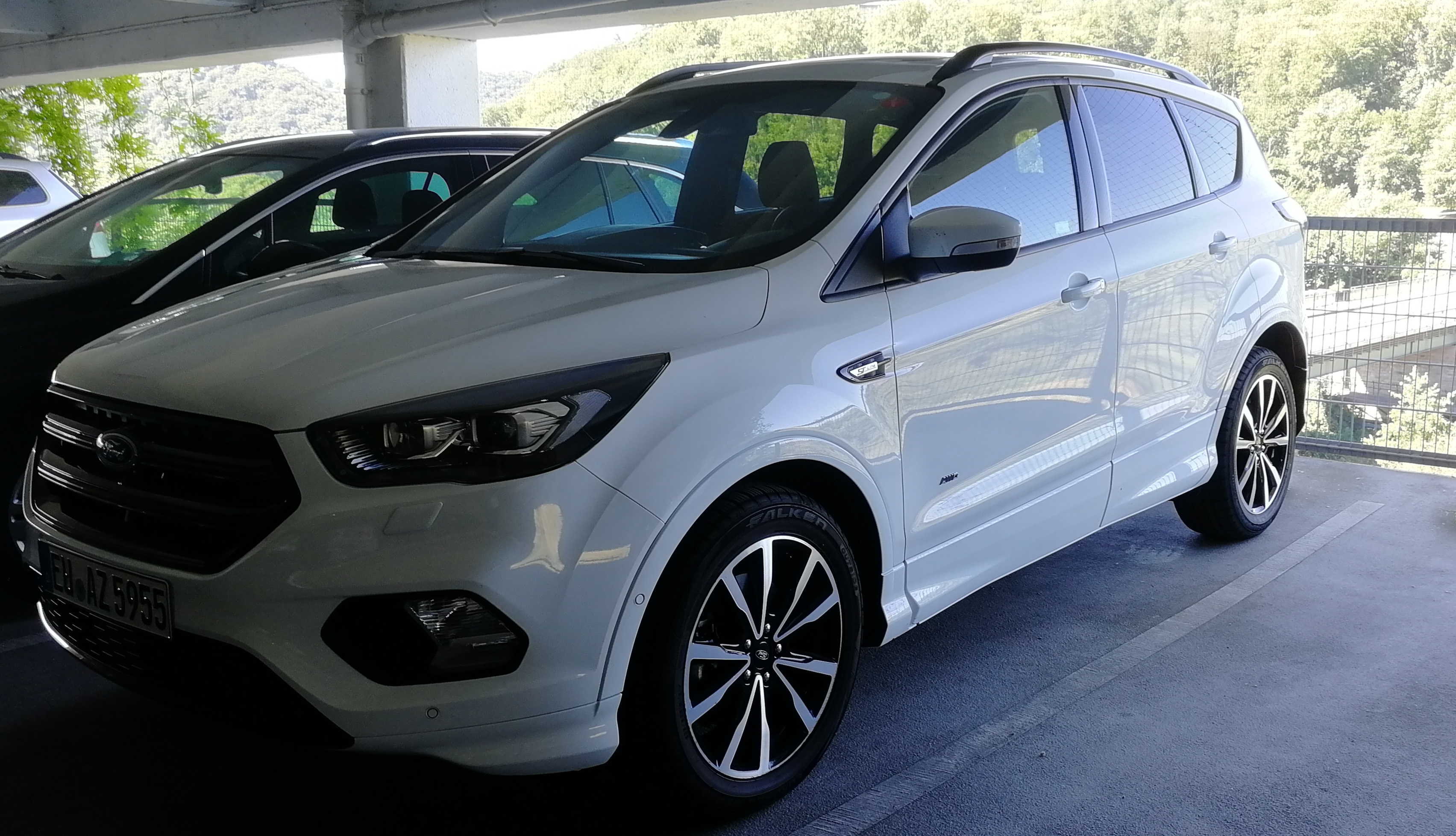
The new model has then been slightly rounded and given a more modern look, and although that previous version did not seem outdated a few months ago, the design language of Ford's new models is of course noticeable when looking at the new model.
Basic knowledge and test driving experience
You can get a fairly comprehensive overview of the new Kuga PHEV model by watching Antti Liinpää's video (which is unfortunately in Finnish). Unlike the model I tested, the car presented in the video is an ST-Line equipped version, but both have the same power line, i.e. quoting a press release:
The Power-split power line, which produces a total of 225 hp, consists of a 2.5-liter four-cylinder Atkinson petrol engine, electric motor and generator, as well as a 14.4 kWh lithium-ion battery.
The operation of the power line is illustrated in Ford's introductory video, where the effects of different modes of operation are shown by animating the car's structures, and this helps to understand both the car's structure and the power line's operating options.
To me all the steering wheel buttons and other menu buttons were easily found in the places that were etched in the memory for the previous Ford Focus ST-Line test drive. This in itself is not surprising, as the new Kuga is based on the same C2 platform design as the Focus, and at least the cab is also very largely identical to the Focus. The gear selector is the same round "Drive by wire" gear selector, which also makes life easier so that the car can be switched off directly without first putting the transmission into P gear. So in the following picture you can see the Kuga PHEV cab, not the Focus ST cab, although the resemblance, with the exception of the ST Line trim, is quite obvious.
My own test drive started with a full battery when the first trip was driven between Vantaa and Hyvinkää. This 51 km journey, which naturally consumes battery power due to a 120 km / h motorway section, consumed on a hybrid setting and eco driving mode 1.5 l / 100 km of petrol and 36 km of electric driving. There was only 15 km of battery left at the destination, but the estimate of the distance that can be reached by petrol was still the same 697 km, which it had been at the time of departure.
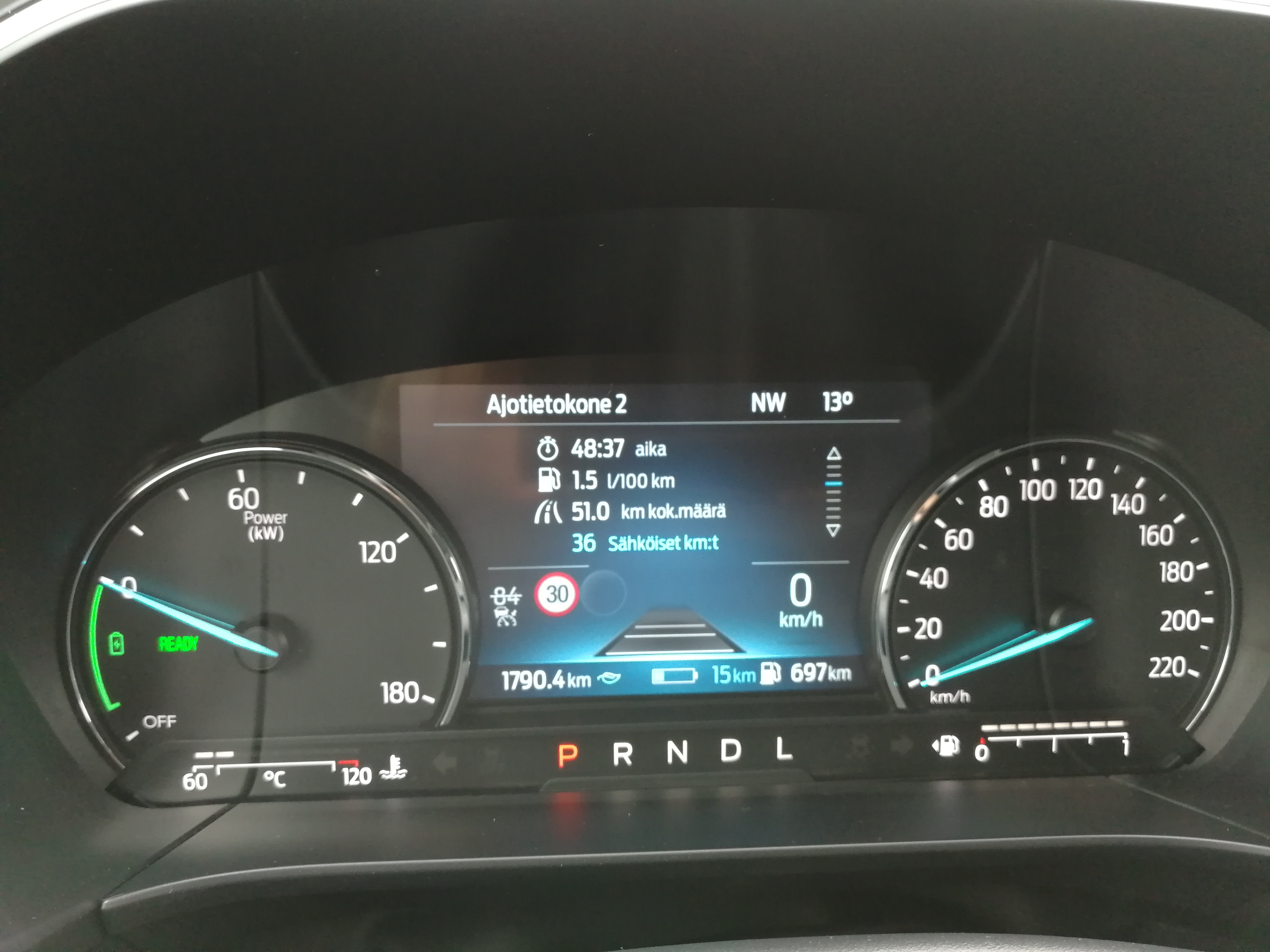
Due to time challenges, the next journey then began almost immediately. The car was now loaded with children and goods, but with the battery promised still only those 15 km of electrical drive. This trip was a 75 km long cottage trip which mainly consists of 100 km / h and 80 km / h roads, but also includes a 10 km section of 120 km / h motorway and the same amount of city driving. At the end this, to be exact, 76.1 km distance, had consumed 4.0 l / 100 km of gasoline and 36 km of electric kilometers. It is confusing, however, to see that 36 km of electrical drive as initially at the start the estimation had been 15 km of electrical drive. Of course, when driving in L mode of the transmission, the car applies regenerative braking while driving when the accelerator pedal is released, so the value is likely to be explained by the collected wasted energy.
In terms of technical data, the lack of ground clearance information in Ford’s materials was very surprising. There is no mention of ground clearance in the brochure at all, and unfortunately the online manual in HTML format does not work either. Quite miraculous, as I think more buyers, let alone users, might be interested in such information. Iltalehti magazine has found readings of 139-160 mm in their story. In the Moottori.fi story, 160 mm of ground clearance is mentioned for the car in question, because the battery placed in the bottom lowers the ground clearance. However, what ever was the correct value, there seemed to be enough ground clearance for the cottage road, and although the front bumper collected all the dandelions on the center line of the road for decoration, there seemed to be more ground clearance than on my own Skoda Octavia's 141 mm.
According to additional information received from the importer after the test run, the ground clearance of the Kuga PHEV is always 160 mm. The normal ground clearance is 191 mm for Titan models, 190 mm for Vignale models and 178 mm for ST-Line model. So the battery of the PHEV drops ground clearance in all of these models, but the value is still high compared to passenger cars.
While at the cottage, it was good to get a feel for the capacity of the tailgate. In the traditional box test of the Liisari.fi website, the back container absorbed three boxes.
However, Kuga offers the possibility to move the rear seats forward 15 cm, which increases the size of the boot by 67 liters. In the new box test, four lower boxes seem to fit on the bottom, but unfortunately the tailgate itself eats up some of this illusion and does not electronically agree to push the contents tighter. Fortunately, however, the car is so high that the boxes could be stacked on top of each other, if necessary, so that the tailgate can hold a lot of payload, as in the following picture four boxes, and one more would still fit well into the trunk.
When I find out the official volume readings of the trunk, the lightness of the technical data in the Kuga brochures once again annoys me as representative of the engineering community. The already mentioned Iltalehti article reports 441-581 l in liters. Nettiauto article mentions 441 l for PHEV and 475 l for other models. The official brochure also has 645 l for PHEV, on the one hand, with the note that when the seats are upright, there is a volume of 581 l which does not make sense.

The German material does not disappoint in its accuracy, so the corresponding brochure lists the same figures on a more detailed level, having the PHEV model values nicely separated.
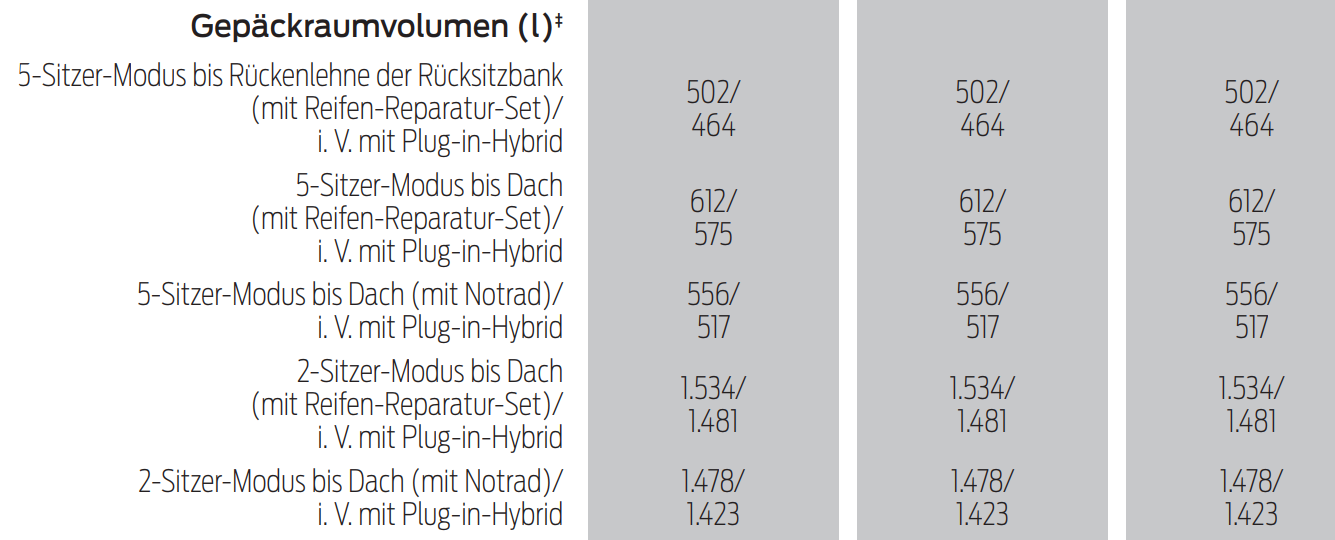
The only problem is that although both brochures refer to the same ISO standard, there are clearly already differences in the figures for the basic model. I also had a look at the UK figures in their brochure, but the differences between the figures seem to be only widening.

In the end, I checked the measurement with the importer, in response to which the official figure for Finland when the rear seats were moved to the front position is 581 l. So let's accept it.
With the rear seats moved to the front position, the legroom of the rear passengers has naturally shrunk. For example, it is pointless to imagine using a large floor-mounted child seat in this position, but otherwise, at least for shorter passengers, there is still a quite functional legroom.
Next destination was few hundred kilometers away on Vaasa. Before that, however, I had to take some video of the electronic propagation in the terrain. The reasonably steep uphill of the cottage road has caused small bumps in the front wheels in some cars, but this was not noticeable in the case of the Kuga. You can follow the progress and the sound in the following video, which can also be found on Liisari's YouTube channel.
The next trip with four hours of driving was a good opportunity to get to know more about the vehicle. Based on this trip I felt that the long cruise went by smoothly and the driver's seat was well suited for me as a 177 cm driver, even though the Nettiauto story and TM magazine's story were hoping that the ST-Line seat section could be slightly longer. Few times I was overtaking another cars and at those times Kuga seemed to accelerate really nicely to overtaking speeds. Thus, at least whit this much power, the CTV transmission did not appear to interfere in any way with the overtaking acceleration. The noise, of course, increased momentarily, but the rubber band-likeness of the previous Toyota Auris test drive didn’t really become any observation here.
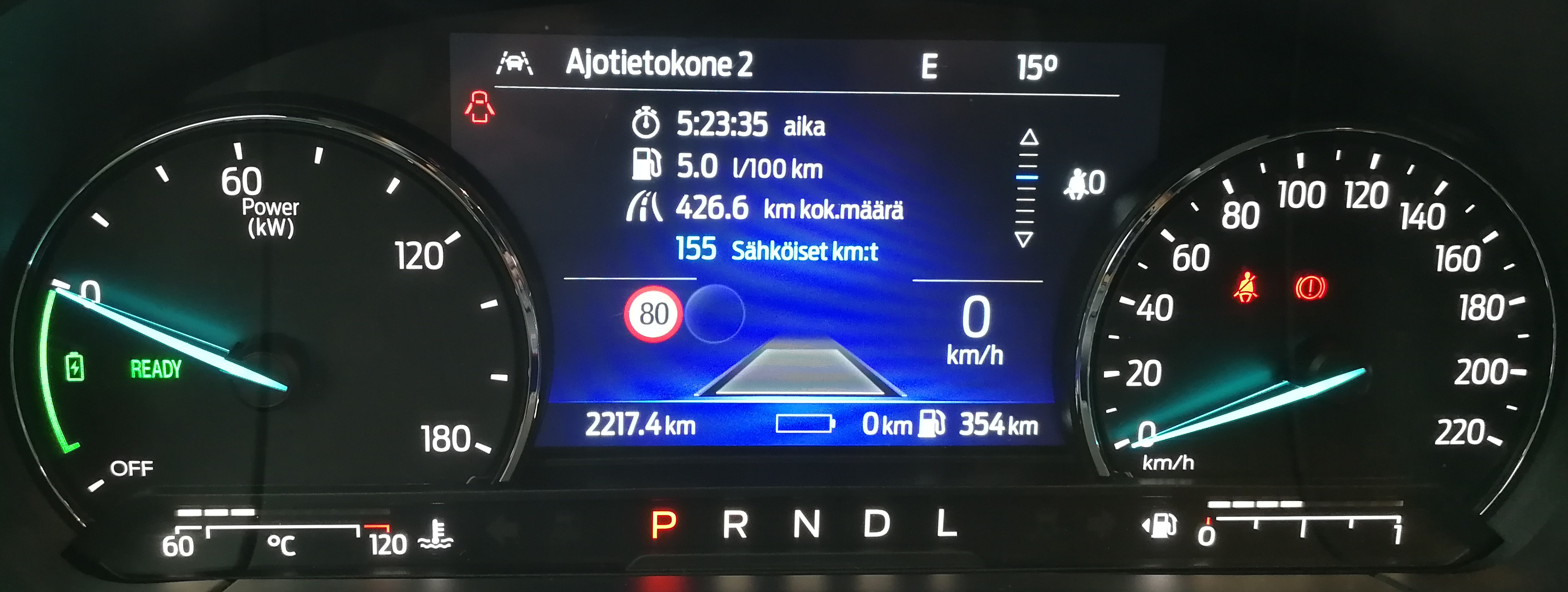
The total distance of 427 km for Hyvinkää-Tammela-Vaasa was driven at an average speed of 79.12 km / h. For the full trip the average consumption was 5,0 l / 100 km. During the trip as many as 155 kilometers were driven using electricity even though the battery had only electricity for 15 km when we started. That's more than a third of the total distance! Mainly the road was 100 km / h restricted. On arrival, a few pictures of the car were taken in the green Kyrönjoki river scenery.
Another photo by Tuulikki Lahti

The next trip to the center of Vaasa was to be handled purely electrically as the battery had been fully charged during the night. Although the journey was started by selecting Electric driving mode, the engine started in hybrid mode as soon as we got on the road. According to the display, the reason for gasoline usage was "normal operation of the car", which did not really reveal the root cause of gasoline consumption. I tried to turn off the air conditioning and ventilation, but it had no effect. The first 9 km were then driven in hybrid mode. In total our round trip was for 50 km and out of that 40 km were driven with electricity. The battery still had 13 km left at the destination. It was not this time possible to get measurements for fully electric drive distance, but the consumption was, however, quite moderately, 0.8 l / 100 km.

Next it was time to take a closer look at the car by peeking into the engine compartment. Generally it looks like the maintenance person will have quite a lot of work to do if any major repairs have to be done. Fortunately for the user, the most important checks have been made readily available, and the windshield washer fluid can also be conveniently filled from the left edge. According to the manual, the engine oil must be changed every 16 000 km or once a year under normal conditions which means that you need to service the car fairly often.
The car has pretty large mirrors that make it comfortable to see what happens on the back. This helps especially when you attach a trailer to the car. However, when coupling a trailer, the car is forcefully propelled by an internal combustion engine. As for the mirrors, I initially wondered if they completely lacked the possibility of heating when such a button was not visible. Later I found from the manual that their heating was connected to the rear window heating. An interesting solution, I often use the heating of the mirrors in their rain to dry the mirrors and thus improve the visibility.
At the the backseat, there are heaters for the rear passengers, one USB connector and a very special power plug that looks more like a UK plug. The same thing was wondered about in the Youtube video I watched. They speculated that it might be a feature of the press car, but apparently the same plug is also present in the Finnish models. According to the manual, "depending on the country of manufacture, the voltage supply is either 110 volts or 230 volts". Well, at least it seemed to work fine with the USB charger that one of my passenger had already plugged in so that gets power to his tablet computer.
While reading the manual I also found surprising information about the L mode of the gearbox. According to the manual L-mode, that produces the highest engine braking, can be used at any speed, but it was also written as follows:
... is not intended for use for long periods or under normal driving conditions. The slow position worsens fuel economy.
Personally, I had driven all the trips in L mode because I think it’s nice to drive in that mode, at least if there are multiple intersections on the trip. In addition, the feel of the Kuga brake pedal was somehow quite raucous, especially if it tried to drop the cruise control out of the game momentarily, so often a small touch already produced a bigger jerk.
The journey home started again with a full battery and the first stop at 21.1 km was reached with 12 km of electric kilometers and 2.2 l / 100 km consumption. So again, gasoline was burned in the beginning, even though there was power in the battery. At first, I imagined this to be some kind of momentary state equivalent to the combustion of diesel particles, but when the same phenomenon is repeated several times, it must be a feature of the car. The lack of all-electric ride also seems to have amazed Moottori magazine in its own story , which actually seems to be about the very same Kuga car. It would be interesting to hear in the comments more about the experiences what others have had.
At Ikaalinen, I had to stop for refueling of passengers, when the odometer had 207.7 km with a consumption of 4.6 l / 100 km and 76 electric kilometers with an average speed of 80.14 km / h. The battery was charged for 50 minutes from the shopping center's plug to a level of 32%, which according to the instrument panel meant 15 km more for electric driving.
At the beginning of the Tampere motorway, 266.8 km had been driven with a consumption of 4.5 l / 100 km and 106 km electric kilometers, all with an average speed of 80.85 km / h. Even the average speed had now increased by 0.71 km / h, the previous 50 min charging made a 0.1 l / 100 km drip into consumption. At this point, at the start of the highway, the battery was already empty. The motorway-focused journey from Tampere to Hyvinkää concluded our total values for 389.8 km as consumption of 5.1 l / 100 km and 120 electric kilometers at an average speed of 86.6 km / h.
As the car still had to be returned at the same evening, the journey continued immediately after dropping passengers and unloading cargo to my home. This mean a ride with an empty battery from Hyvinkää to Vantaa. Finally the result for the day was 443.4 km with a consumption of 5.1 l / 100 km and 137 electric kilometers. The average speed for the whole distance was 81.5 km / h, because the journey involved quite a lot of road work.
On the last trip, the car's electronic features also had to be tested and it must be said that the automatic speed control function with tolerances found in the car was a really good feature. There have been road sign recognition and auto-adjusting speeds in other cars as well, but gauge errors usually make them virtually unusable unless you want to drive under common speeds on congested roads. With the help of tolerance, for example, 84 km / h -> 104 km / h acceleration (or equivalent deceleration) takes place nicely automatically. I also had a lane guard on and it was very active in its role, trying to keep the car in the middle of my lane all the time. On the other hand, a light one-handed ride then produced a call to hold the steering wheel.
As a whole, the rides with Kuga formed a rather high-quality and quiet impression. Noise seems to be a bit of a relative concept, especially when you read a few of the Kuga articles I’m already referring to in this story, you might notice that some of them complain about tire noise. However, I think the Kuga was at least clearly quieter than my daily car Skoda Octavia , but maybe other writers have jumped on the Kuga more from premium cars. Ford has at least worked for silence as part of their " Whisper strategy " program. by optimizing the structures of the platform. As part of the program, they also published the following picture of sound levels from different eras. The work must have started some time ago, because I remember mentioning silence in my Ford Mondeo story, and at the same time the same was mentioned in other articles about Mondeo .
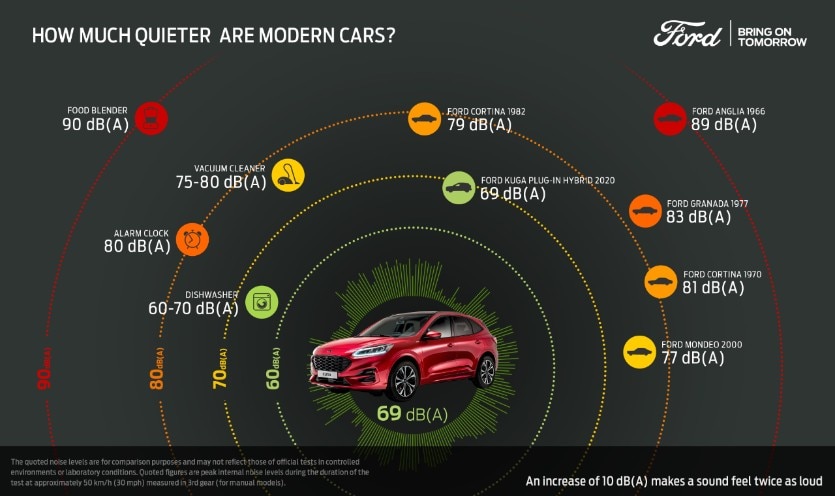
The most disturbing feature in Kuga was the lack of a ski hatch, or a loading hatch. In a previous Mondeo case, I was amazed at the miserably small size of the ski hatch and now it’s completely out of range because it can’t even be found in the list of accessories. So you always have to knock down the back seat to transport skis or other longer items, and even a short ski holiday for a family of four requires a ski box on the roof. Other than that, I would definitely be ready to spend a four-year contract period at the helm of Kuga.
At the time of writing (19.11.2019 price list), this Titanium X-equipped Ford Kuga PHEV costs exactly € 40,000 tax-free, and because the car tax on the rechargeable hybrid is quite moderate, with taxes € 41,281.43. As limited car benefit, this means 635 € / month and according to the Liisari.fi website's accessory calculator, this enables the purchase of accessories within the same tax value for as much as 1539.99 euros. Within this framework, a profitable purchase is a Driver Assistance Pack worth at least € 1,300, which brings with it an adaptive Cruise Control. The Ford version of the adaptive cruise control can also continue the journey after stopping, which is a nice feature especially when driving in traffic jams. Here is a quote from the entire package:
- Active cruise control (stop & go congestion function in automatic transmissions, including line assist) - Driver Alert - BLIS and intersection warning system with active braking - Active parking assist (automatic) (automatic) Front and Rear - Front & Reversing Camera (180 degrees)
An interesting finding relates to the door edge protectors, which Skoda introduced along with its Kodiaq model as standard on the car to protect the car and also adjacent cars from bumps. It is interesting because another Simply Clever solution familiar from Skoda, which is the reversible boot mat, can be found in the accessories list as well. Without knowing exactly who owns all these patents, one needs only to note that Superb-style umbrellas did not yet appear in the list of accessories for Kuga.
As a small word of warning, I'd like to add that it is not advisable to carry very small objects in the center console bottle holder... I lost a small screw from a GoPro mount as the bottom of the bottle holder had a spring or something attached to it. Fortunately, earlier investments had been made at my house to a long-arm magnet.
Oh, and if anyone is wondering what that remarkable meeting mentioned at the beginning was, then the intention was to meet Pepe, a little kitty we met for the first time. :-)

Photo by Jaana Mäkynen
